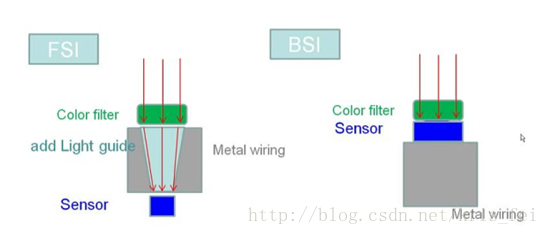The higher the resolution, the more detail can be seen when the photo is enlarged. 03:00
Sensor structure:
lens /color filter/ photosensitive area, lens collects a specific color of light, color filter filters other colors of light, and projects one color of light to the photosensitive area. 04:07
Connection mode of Sensor and substrate:
COB: module gets the sensor die and connects the sensor to the substrate through the gold wire.
CSP/TSF: The sensor has been connected to the substrate and packaged when shipped. 06:00
Note: MIPI layout:
Mipi signal line is equal length and symmetrical
The hole position is symmetrical
Estimate of Layout transition place 06:31
Sensor manufacturing process
There are BSI and FSI, BSI is better. Relatively can support thinner components, large aperture, higher brightness. 10:00
Sensor's Responsiveness refers to the photoelectric conversion efficiency, in V/Lux-sec. (Output voltage per unit of illumination) 10:45
IR cut and Blue Galss:
The function of IR cut is to filter out (reflect back) the light frequency that the human eye can not see, and the human eye can see 400~700nm.
Blue glass absorbs infrared rays and is not easy to do secondary reflection inside. 22:50
The image circle of the Lens needs to cover the sensitive area of the sensor. 25:00
Lens shading:
It refers to the uneven distribution of light, such as lighting in the center and extending outward to dim. This is mainly because most of the light is concentrated in the middle, and because the imaging locations of different wavelengths are different. 27:00
FNO. Calculation:
Fno.= f/A f is the focal length and A is the aperture size. 29:00
TTL:
The distance from the lens surface to the sensor surface. This definition facilitates calculation of module height.
module height = TTL + sensor thickness + substrate height
FOV:
The viewing Angle of the module must be consistent with the Angle of the lens, otherwise when the Angle of the lens is relatively large, there may be a dark Angle.
CRA:
Angle from mirror center to photosensitive area.
When CRA does not match, it causes color shading phenomenon.
CRA suggestion: Lens CRA < Sensor CRA; otherwise, light is easily reflected. In addition, the CRA should match,
The difference between a Lens and a Sensor is within 2°. 36:00
After Sensor's decision, determine lens.40:51 according to image circle and CRA
CRA may refer to http://www.opticsky.cn/simple/t11533.html
VCM
There are open loop and closed loop two, closed loop has close loop and OIS two. 48:00
The closed loop has relatively higher accuracy and faster focusing speed, and the power consumption is also low, and the imaging effect is more prominent in low light conditions. The disadvantage is that the software compatibility is poor and needs to be redeveloped and debugged.
OIS > close loop > open loop
Reference: http://blog.csdn.net/daisyhd/article/details/18554629
From:
720p_Camera_module_device.mp4
— — — — — — — —
Copyright Notice: This article is CSDN blogger "KrisFei" original article, in accordance with CC 4.0 BY-SA copyright agreement, please attach the original source link and this notice.
The original link: https://blog.csdn.net/kris_fei/article/details/77150567



